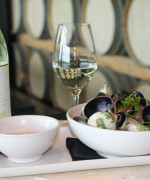Bottles of low alcohol wines are increasingly appearing on the shop shelves – what’s behind the surge in supply? And can they really compete with the traditional, higher-alcohol stuff?
Low-alcohol wine? Surely that’s something you might pour for your nana to stop her nodding off over dinner? Or a designated driver, served with a heart-felt sigh of sympathy. Perhaps once a upon a time – but no more.
Low-alcohol options are a rapidly growing trend in the global drinks biz. What began with the burgeoning of good quality low-alcohol beer several years ago has blossomed now into increasing choice for alcohol-savvy wine drinkers as well. But the key to the wines’ success lies not in increasing quantity, but vastly improved quality.
As winemakers increasingly take low-alcohol varieties seriously, the wines are becoming something you drink because it’s a good wine, not because they’re just good within the scope of your low-alcohol options.
Nikolai St George, winemaker at Matua Valley, says the winery’s First Frost Sauvignon Blanc, launched in Australia a couple of years ago is now selling at huge volumes.
“A lot of a drive in consumption in Australia comes from lunches and after-work drinks,” he says “With the larger city bases over there you have more of a culture of business lunches, and if you’re having them with wine, you’re really watching what you drink and conscious of how much you are drinking. I think that’s where a low alcohol wine comes into its own. “
Calorie-consciousness is also a selling point, since much of the calorie content of wine is alcohol.
Here in New Zealand market, Brancott Estate winemakers have also released a low-alcohol wine range to stay abreast of market demand and expand consumer choice. The Flight range includes a sauvignon blanc, reisling and a pinot gris.
But for all those long lunches are driving demand, the wine must still taste good.
“Alcohol lifts aromas,” says St George. “Just like in perfume, you have alcohol, to give you a real punch, real intensity of aroma. That’s what it also does in wine: it holds on to those aromas to make them more volatile.
“You’re never going to achieve the same type of wine [that you get with a higher alcohol content], but with the know-how of making the wine as good as possible,we’re still getting some great quality out of it.”
Because alcohol does affect the palate weight, or mouth-feel of the wine, St George says you have to find that balance another way.
At Matua, winemakers correct for mouth feel by increasing the sugar slightly – not too much because they’re still conscious of the calories. They use techniques developed by Australian sister company Lindemann’s to extract the alcohol without extracting other elements that impact on the mouth feel.
At Brancott Estate, winemaker Patrick Materman and his team have a different approach. They opt to reduce alcohol content naturally by harvesting early in the grape ripening phase, when the sugar levels are lower. They then carefully monitor the fermentation process.
The method was developed with assistance from researchers at Victoria University, studying the fermentation process and aromas of sauvignon blanc.
They key success of Flight is that the tasting profile of the wines is true to their variety, he says.
Sauvignon blanc grape varieties naturally lend themselves to low alcohol wine, as does, to a lesser extent, riesling. “Because you’re starting off with such a punchy, aromatic wine, even if you lose a bit of the aromatic quality, you still have a lot there,” says St George.
When it comes to the consumer wanting to make the switch to low-alcohol wines, and still be able to perfectly match them with their food, it’s simple, says St George. “The guidelines are the same as for higher alcohol wines.”
His only advice would be to make sure the wine’s not going to be swamped or dominated by flavours in the food. “Lower alcohol wine options work well with lighter or crisper foods, such as sushi or salads with vinaigrette. That’s another reason they’re drunk a lot with lunch.”
Try these:
So, you’ve made the switch to low alcohol wines, but need some advice on what to eat with them. The wine makers at Brancott have some basic food-match recommendations for their Flight wines.
- Brancott Estate Flight Waipara Riesling: Fresh sashimi
- Brancott Estate Flight Marlborough Pinot Gris: panfried salmon with fresh, steamed vegetables
- Brancott Estate Flight Marlborough Sauvignon Blanc: barbecued shrimps or prawns




